Infertility
Inability to conceive; Unable to get pregnant
Infertility means you cannot get pregnant (conceive).
There are 2 types of infertility:
- Primary infertility refers to couples who have not become pregnant after at least 1 year having sex without using birth control methods.
- Secondary infertility refers to couples who have been able to get pregnant at least once, but now are unable to do so.
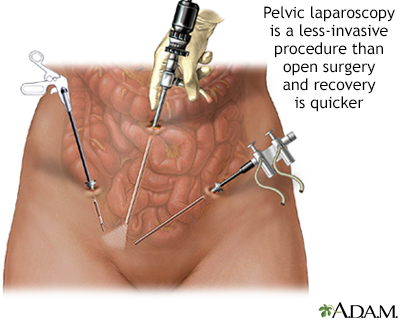
Laparoscopy is performed when less-invasive surgery is desired. It is also called Band-Aid surgery because only small incisions need to be made to accommodate the small surgical instruments that are used to view the abdominal contents and perform the surgery.
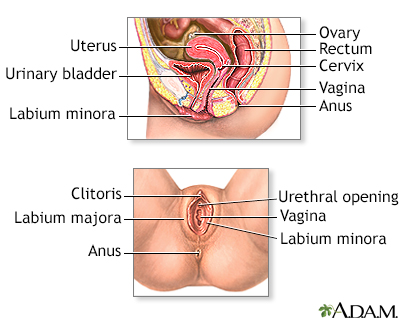
External structures of the female reproductive anatomy include the labium minora and majora, the vagina and the clitoris. Internal structures include the uterus, ovaries, and cervix.
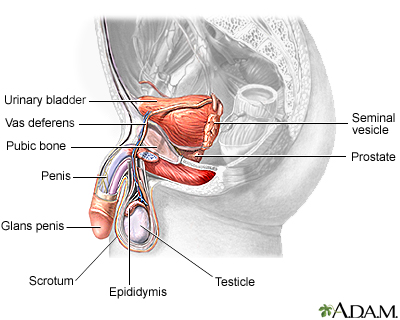
The male reproductive structures include the penis, the scrotum, the testes, the epididymis, the seminal vesicles, and the prostate.
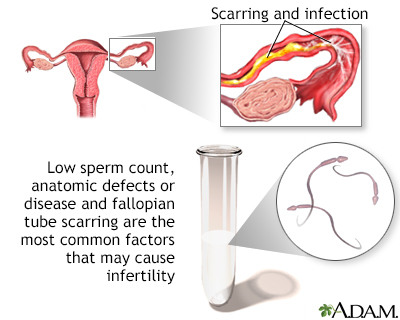
Primary infertility is a term used to describe a couple that has never been able to conceive a pregnancy after a minimum of 1 year of attempting to do so through unprotected intercourse. Causes of infertility include a wide range of physical as well as emotional factors.
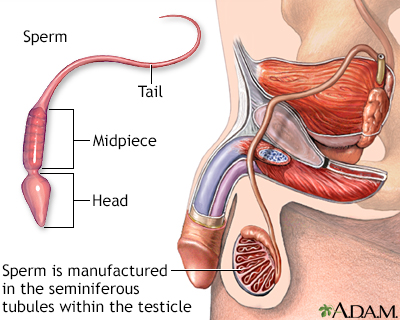
The male reproductive system creates sperm that is manufactured in the seminiferous tubules within each testicle. The head of the sperm contains the DNA, which when combined with the eggs DNA, will create a new individual. The tip of the sperm head is the portion called the acrosome, which enables the sperm to penetrate the egg. The midpiece contains the mitochondria which supplies the energy the tail needs to move. The tail moves with whip-like movements back and forth to propel the sperm towards the egg. The sperm have to reach the uterus and the fallopian tube in order to fertilize a womans egg.
Causes
Many medical conditions can cause infertility. It may be due to problems in the woman, man, or both.
FEMALE INFERTILITY
Female infertility may occur when:
- A fertilized egg or embryo does not survive once it attaches to the lining of the womb (uterus).
- The fertilized egg does not attach to the lining of the uterus.
- The eggs cannot move from the ovaries to the womb.
- The ovaries have problems producing healthy eggs.
Female infertility may be caused by:
- Autoimmune disorders, such as antiphospholipid syndrome (APS)
- Birth defects that affect the reproductive tract
- Cancer or tumor
- Clotting disorders
- Diabetes
- Drinking too much alcohol
- Exercising too much
- Eating disorders or poor nutrition
- Growths (such as fibroids or polyps) in the uterus and cervix
- Medicines such as chemotherapy drugs
- Failure to ovulate
- Being overweight or underweight
- Older age
- Ovarian cysts and polycystic ovary syndrome (PCOS)
- Pelvic infection resulting in scarring or swelling of fallopian tubes (hydrosalpinx) or pelvic inflammatory disease (PID)
- Scarring from sexually transmitted infection, abdominal surgery or endometriosis
- Smoking
- Surgery to prevent pregnancy (tubal ligation) or failure of tubal ligation reversal (reanastomosis)
- Thyroid disease
MALE INFERTILITY
Male infertility may be due to:
- Decreased number of sperm
- Blockage that prevents the sperm from being released
- Defects in the sperm
Male infertility can be caused by:
- Birth defects
- Cancer treatments, including chemotherapy and radiation
- Exposure to high heat for prolonged periods
- Heavy use of alcohol, marijuana, or cocaine
- Benign pituitary tumor (causing high blood level of prolactin)
- Diabetes (uncontrolled)
- Hypogonadism causing low levels of the male hormone testosterone
- Impotence
- Infection
- Medicines such as cimetidine, spironolactone, and nitrofurantoin
- Obesity
- Older age
- Retrograde ejaculation
- Scarring from sexually transmitted infections (STIs), injury, or surgery
- Smoking
- Toxins in the environment
- Vasectomy or failure of vasectomy reversal
- History of testicular infection from mumps
Healthy couples under age 30 who have sex regularly will have about a 20% per month chance of getting pregnant each month.
A woman is most fertile in her early 20s. The chance a woman can get pregnant begins to decrease around age 35 (and especially after age 40). The age when fertility starts to decline varies from woman to woman.
Infertility problems and miscarriage rates increase significantly after 35 years of age. There are now options for early egg retrieval and storage for women in their 20's. This may help ensure a successful pregnancy if childbearing is delayed until after age 35. This is an expensive option. However, women who know they will need to delay childbearing may consider it.
Exams and Tests
Deciding when to get treated for infertility depends on your age. Health care providers suggest that women under 30 try to get pregnant on their own for 1 year before getting tested for conditions that may cause infertility.
Women over 35 should try to get pregnant for 6 months. If it does not occur within that time, they should talk to their provider.
Infertility testing involves a medical history and physical exam for both partners.
Blood and imaging tests are most often needed. In women, these may include:
- Blood tests to check hormone levels, including progesterone and follicle stimulating hormone (FSH)
- Home urine ovulation detection kits
- Measurement of body temperature every morning to see if the ovaries are releasing eggs (ovulating)
- FSH and clomid challenge test
- Antimullerian hormone testing (AMH)
- Hysterosalpingography (HSG) to look for blockages in the fallopian tubes
- Pelvic ultrasound to check egg quality and evaluate the uterus
- Laparoscopy
- Thyroid function tests
- Blood tests to detect a prior chlamydia infection (which can cause tubal damage)
Tests in men may include:
- Sperm testing
- Exam of the testes and penis
- Ultrasound of the male genitals (sometimes done)
- Blood tests to check hormone levels
- Testicular biopsy (rarely done)
Treatment
Treatment depends on the cause of infertility. It may involve:
- Education and counseling about the condition
- Fertility treatments such as taking medicine to induce ovulation, intrauterine insemination (IUI), and in vitro fertilization (IVF)
- Medicines to treat infections and clotting disorders
- Medicines that help the growth and release of eggs from the ovaries
Couples can increase the chances of becoming pregnant each month by having sex at least every 2 days before and during ovulation.
Ovulation occurs about 2 weeks before the next menstrual cycle (period) starts. Therefore, if a woman gets her period every 28 days the couple should have sex at least every 2 days between the 10th and 18th day after her period starts.
Having sex before ovulation occurs is especially helpful.
- Sperm can live inside a woman's body for at least 2 days.
- However, a woman's egg can only be fertilized by the sperm within 12 to 24 hours after it is released.
Women who are under or overweight may increase their chances of becoming pregnant by getting to a healthier weight.
Support Groups
More information and support for people with infertility and their families can be found by joining a local support group. You can ask your provider to recommend local groups.
Outlook (Prognosis)
As many as 1 in 5 couples diagnosed with infertility eventually become pregnant without treatment.
Most couples with infertility become pregnant after treatment.
When to Contact a Medical Professional
Contact your provider if you are not able to get pregnant.
Prevention
Preventing STIs, such as gonorrhea and chlamydia, may reduce your risk of infertility.
Maintaining a healthy diet, weight, and lifestyle may increase your chance of getting pregnant and having a healthy pregnancy.
Avoiding the use of lubricants during sex may help improve sperm function.
References
American Society for Reproductive Medicine website. Diagnosis and treatment of infertility in men: AUA/ASRM guideline part 1 (2021).
Catherino WH. Reproductive endocrinology and infertility. In: Goldman L, Cooney KA, eds. Goldman-Cecil Medicine. 27th ed. Philadelphia, PA: Elsevier; 2024:chap 218.
Fauser BCJM, Broekmans FJ. Female infertility: evaluation and management. In: Robertson RP, ed. DeGroot's Endocrinology. 8th ed. Philadelphia, PA: Elsevier; 2023:chap 123.
Lobo RA. Infertility: etiology, diagnostic evaluation, management, prognosis. In: Gershenson DM, Lentz GM, Valea FA, Lobo RA, eds. Comprehensive Gynecology. 8th ed. Philadelphia, PA: Elsevier; 2022:chap 40.
Practice Committee of the American Society for Reproductive Medicine. Fertility evaluation of infertile women: a committee opinion. Fertil Steril. 2021;116(5):1255-1265. PMID: 34607703
Schlegel PN. Clinical management of male infertility. In: Robertson RP, ed. DeGroot's Endocrinology. 8th ed. Philadelphia, PA: Elsevier; 2023:chap 113.
Version Info
Last reviewed on: 1/1/2023
Reviewed by: John D. Jacobson, MD, Professor Emeritus, Department of Obstetrics and Gynecology, Loma Linda University School of Medicine, Loma Linda, CA. Internal review and update on 02/06/2024 by David C. Dugdale, MD, Medical Director, Brenda Conaway, Editorial Director, and the A.D.A.M. Editorial team.
